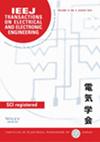下载PDF
{"title":"EMC Research Efforts in the IEEJ Technical Committee and State-of-the-Art Case Studies on ESD Found in its Technical Papers","authors":"Osamu Fujiwara","doi":"10.1002/tee.24152","DOIUrl":null,"url":null,"abstract":"<p>Electrostatic discharge (ESD) has been known to cause electromagnetic noise against electronic equipment and devices even before the technical concept of electromagnetic compatibility (EMC) was established 68 years ago in the United States and 48 years ago in Japan, while the ESD still continues to be studied as one of the most significant issues that should be solved in EMC areas. This is largely because the underlying nature of ESD has yet to be essentially elucidated from an EMC perspective. On the other hand, as an academic research organization on EMC in Japan, a Technical Committee named ‘EMCJ’ on ‘Environmental Electromagnetic Engineering’ was founded in 1976 in both the Institute of Electrical Engineers of Japan (IEEJ) and the Institute of Electronics and Communication Engineers or the present IEICE (Institute of Electronics, Information and Communication Engineers) to address EMC concerns. Since then, the EMCJ has been jointly conducting EMC research activities under the IEICE as the nominating body and the IEEJ as the associative body, whereas the EMCJ of IEEJ was dissolved in 1999 to form a new Technical Committee on EMC (TC-EMC) in order to deal with EMC issues appropriate to the IEEJ. In this review, to mark the 25th anniversary of the IEEJ Technical Committee on EMC (TC-EMC) in 2024, the EMC research efforts and activities that the TC-EMC has conducted over the past 25 years from January 2000 to March 2024 are surveyed from 1272 technical papers presented at the technical meetings. Furthermore, among the ESD issues identified in these technical papers, the latest case studies utilizing ‘spark resistance laws’ that allow the analysis of the initial behavior of sparks, in which a spark is the essence of ESD and is the key to open the door to elucidate the phenomenon, particularly from an EMC perspective, are reviewed. © 2024 Institute of Electrical Engineers of Japan and Wiley Periodicals LLC.</p>","PeriodicalId":13435,"journal":{"name":"IEEJ Transactions on Electrical and Electronic Engineering","volume":"20 1","pages":"4-18"},"PeriodicalIF":1.0000,"publicationDate":"2024-06-18","publicationTypes":"Journal Article","fieldsOfStudy":null,"isOpenAccess":false,"openAccessPdf":"https://onlinelibrary.wiley.com/doi/epdf/10.1002/tee.24152","citationCount":"0","resultStr":null,"platform":"Semanticscholar","paperid":null,"PeriodicalName":"IEEJ Transactions on Electrical and Electronic Engineering","FirstCategoryId":"5","ListUrlMain":"https://onlinelibrary.wiley.com/doi/10.1002/tee.24152","RegionNum":4,"RegionCategory":"工程技术","ArticlePicture":[],"TitleCN":null,"AbstractTextCN":null,"PMCID":null,"EPubDate":"","PubModel":"","JCR":"Q4","JCRName":"ENGINEERING, ELECTRICAL & ELECTRONIC","Score":null,"Total":0}
引用次数: 0
引用
批量引用
Abstract
Electrostatic discharge (ESD) has been known to cause electromagnetic noise against electronic equipment and devices even before the technical concept of electromagnetic compatibility (EMC) was established 68 years ago in the United States and 48 years ago in Japan, while the ESD still continues to be studied as one of the most significant issues that should be solved in EMC areas. This is largely because the underlying nature of ESD has yet to be essentially elucidated from an EMC perspective. On the other hand, as an academic research organization on EMC in Japan, a Technical Committee named ‘EMCJ’ on ‘Environmental Electromagnetic Engineering’ was founded in 1976 in both the Institute of Electrical Engineers of Japan (IEEJ) and the Institute of Electronics and Communication Engineers or the present IEICE (Institute of Electronics, Information and Communication Engineers) to address EMC concerns. Since then, the EMCJ has been jointly conducting EMC research activities under the IEICE as the nominating body and the IEEJ as the associative body, whereas the EMCJ of IEEJ was dissolved in 1999 to form a new Technical Committee on EMC (TC-EMC) in order to deal with EMC issues appropriate to the IEEJ. In this review, to mark the 25th anniversary of the IEEJ Technical Committee on EMC (TC-EMC) in 2024, the EMC research efforts and activities that the TC-EMC has conducted over the past 25 years from January 2000 to March 2024 are surveyed from 1272 technical papers presented at the technical meetings. Furthermore, among the ESD issues identified in these technical papers, the latest case studies utilizing ‘spark resistance laws’ that allow the analysis of the initial behavior of sparks, in which a spark is the essence of ESD and is the key to open the door to elucidate the phenomenon, particularly from an EMC perspective, are reviewed. © 2024 Institute of Electrical Engineers of Japan and Wiley Periodicals LLC.
IEEJ技术委员会的EMC研究工作及其技术论文中关于ESD的最新案例研究
早在电磁兼容(electromagnetic compatibility, EMC)这一技术概念在68年前的美国和48年前的日本被提出之前,人们就已经知道静电放电(ESD)会对电子设备和设备产生电磁噪声,而ESD仍然是EMC领域需要解决的重要问题之一。这在很大程度上是因为ESD的基本性质尚未从EMC的角度得到本质上的阐明。另一方面,作为日本EMC的学术研究组织,1976年在日本电气工程师协会(IEEJ)和电子与通信工程师协会(即现在的IEICE)中成立了一个名为“EMCJ”的“环境电磁工程”技术委员会,以解决EMC问题。此后,EMCJ一直以IEICE为提名机构,IEEJ为联合机构,共同开展EMC研究活动,而IEEJ的EMCJ于1999年解散,成立了新的EMC技术委员会(TC-EMC),以处理适合IEEJ的EMC问题。为了纪念IEEJ EMC技术委员会(TC-EMC)在2024年成立25周年,本文从2000年1月至2024年3月的25年中,在技术会议上发表的1272篇技术论文中,对TC-EMC所做的EMC研究工作和活动进行了调查。此外,在这些技术论文中确定的ESD问题中,利用“火花电阻定律”的最新案例研究允许对火花的初始行为进行分析,其中火花是ESD的本质,是打开门以阐明现象的关键,特别是从EMC的角度进行了审查。©2024日本电气工程师协会和Wiley期刊有限责任公司。
本文章由计算机程序翻译,如有差异,请以英文原文为准。


 求助内容:
求助内容: 应助结果提醒方式:
应助结果提醒方式:


